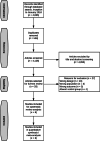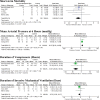Methylene Blue in Septic Shock: A Systematic Review and Meta-Analysis
- PMID: 38904978
- PMCID: PMC11196076
- DOI: 10.1097/CCE.0000000000001110
Methylene Blue in Septic Shock: A Systematic Review and Meta-Analysis
Abstract
Objectives: Although clinicians may use methylene blue (MB) in refractory septic shock, the effect of MB on patient-important outcomes remains uncertain. We conducted a systematic review and meta-analysis to investigate the benefits and harms of MB administration in patients with septic shock.
Data sources: We searched six databases (including PubMed, Embase, and Medline) from inception to January 10, 2024.
Study selection: We included randomized clinical trials (RCTs) of critically ill adults comparing MB with placebo or usual care without MB administration.
Data extraction: Two reviewers performed screening, full-text review, and data extraction. We pooled data using a random-effects model, assessed the risk of bias using the modified Cochrane tool, and used Grading of Recommendations Assessment, Development, and Evaluation to rate certainty of effect estimates.
Data synthesis: We included six RCTs (302 patients). Compared with placebo or no MB administration, MB may reduce short-term mortality (RR [risk ratio] 0.66 [95% CI, 0.47-0.94], low certainty) and hospital length of stay (mean difference [MD] -2.1 d [95% CI, -1.4 to -2.8], low certainty). MB may also reduce duration of vasopressors (MD -31.1 hr [95% CI, -16.5 to -45.6], low certainty), and increase mean arterial pressure at 6 hours (MD 10.2 mm Hg [95% CI, 6.1-14.2], low certainty) compared with no MB administration. The effect of MB on serum methemoglobin concentration was uncertain (MD 0.9% [95% CI, -0.2% to 2.0%], very low certainty). We did not find any differences in adverse events.
Conclusions: Among critically ill adults with septic shock, based on low-certainty evidence, MB may reduce short-term mortality, duration of vasopressors, and hospital length of stay, with no evidence of increased adverse events. Rigorous randomized trials evaluating the efficacy of MB in septic shock are needed.
Registration: Center for Open Science (https://osf.io/hpy4j).
Copyright © 2024 The Authors. Published by Wolters Kluwer Health, Inc. on behalf of the Society of Critical Care Medicine.
Conflict of interest statement
Dr. Seely holds patents related to multiorgan variability analysis and has shares in Therapeutic Monitoring Systems. Dr. Cook is supported by a Canada Research Chair in Critical Care Knowledge Translation. The remaining authors have disclosed that they do not have any potential conflicts of interest.
Figures
References
-
- Sacha GL, Lam SW, Wang L, et al. : Association of catecholamine dose, lactate, and shock duration at vasopressin initiation with mortality in patients with septic shock. Crit Care Med 2022; 50:614–623 - PubMed
Publication types
MeSH terms
Substances
Grants and funding
LinkOut - more resources
Full Text Sources
Miscellaneous



